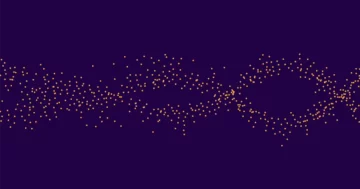On May 12, at nine simultaneous press conferences around the world, astrophysicists revealed the first image of the black hole at the heart of the Milky Way. At first, awesome though it was, the painstakingly produced image of the ring of light around our galaxy’s central pit of darkness seemed to merely prove what experts already expected: The Milky Way’s supermassive black hole exists, it is spinning, and it obeys Albert Einstein’s general theory of relativity.
And yet, on closer inspection, things don’t quite stack up.
From the brightness of the bagel of light, researchers have estimated how quickly matter is falling onto Sagittarius A* — the name given to the Milky Way’s central black hole. The answer is: not quickly at all. “It’s clogged up to a little trickle,” said Priya Natarajan, a cosmologist at Yale University, comparing the galaxy to a broken showerhead. Somehow only a thousandth of the matter that’s flowing into the Milky Way from the surrounding intergalactic medium makes it all the way down and into the hole. “That’s revealing a huge problem,” Natarajan said. “Where is this gas going? What is happening to the flow? It’s very clear that our understanding of black hole growth is suspect.”
Over the past quarter century, astrophysicists have come to recognize what a tight-knit, dynamic relationship exists between many galaxies and the black holes at their centers. “There’s been a really huge transition in the field,” says Ramesh Narayan, a theoretical astrophysicist at Harvard University. “The surprise was that black holes are important as shapers and controllers of how galaxies evolve.”
These giant holes — concentrations of matter so dense that gravity prevents even light from escaping — are like the engines of galaxies, but researchers are only beginning to understand how they operate. Gravity draws dust and gas inward to the galactic center, where it forms a swirling accretion disk around the supermassive black hole, heating up and turning into white-hot plasma. Then, when the black hole engulfs this matter (either in dribs and drabs or in sudden bursts), energy is spat back out into the galaxy in a feedback process. “When you grow a black hole, you are producing energy and dumping it into the surroundings more efficiently than through any other process we know of in nature,” said Eliot Quataert, a theoretical astrophysicist at Princeton University. This feedback affects star formation rates and gas flow patterns throughout the galaxy.
But researchers have only vague ideas about supermassive black holes’ “active” episodes, which turn them into so-called active galactic nuclei (AGNs). “What is the triggering mechanism? What is the off switch? These are the fundamental questions that we’re still trying to get at,” said Kirsten Hall of the Harvard-Smithsonian Center for Astrophysics.
Stellar feedback, which occurs when a star explodes as a supernova, is known to have similar effects as AGN feedback on a smaller scale. These stellar engines are easily big enough to regulate small “dwarf” galaxies, whereas only the giant engines of supermassive black holes can dominate the evolution of the largest “elliptical” galaxies.
Size-wise, the Milky Way, a typical spiral galaxy, sits in the middle. With few obvious signs of activity at its center, our galaxy was long thought to be dominated by stellar feedback. But several recent observations suggest that AGN feedback shapes it as well. By studying the details of the interplay between these feedback mechanisms in our home galaxy — and grappling with puzzles like the current dimness of Sagittarius A* — astrophysicists hope to figure out how galaxies and black holes coevolve in general. The Milky Way “is becoming the most powerful astrophysical laboratory,” said Natarajan. By serving as a microcosm, it “may hold the key.”
Galactic Engines
By the late 1990s, astronomers generally accepted the presence of black holes in galaxies’ centers. By then they could see close enough to these invisible objects to deduce their mass from the movements of stars around them. A strange correlation emerged: The more massive a galaxy is, the heavier its central black hole. “This was particularly tight, and it was totally revolutionary. Somehow the black hole is talking to the galaxy,” said Tiziana Di Matteo, an astrophysicist at Carnegie Mellon University.
The correlation is surprising when you consider that the black hole — big as it is — is a scant fraction of the galaxy’s size. (Sagittarius A* weighs roughly 4 million suns, for instance, while the Milky Way measures some 1.5 trillion solar masses.) Because of this, the black hole’s gravity only pulls with any strength on the innermost region of the galaxy.
To Martin Rees, the United Kingdom’s Astronomer Royal, AGN feedback offered a natural way to connect the relatively tiny black hole to the galaxy at large. Two decades earlier, in the 1970s, Rees correctly hypothesized that supermassive black holes power the luminous jets observed in some far-off, brightly glowing galaxies called quasars. He even proposed, along with Donald Lynden-Bell, that a black hole would explain why the Milky Way’s center glows. Could these be signs of a general phenomenon that governs the size of supermassive black holes everywhere?
The idea was that the more matter a black hole swallows, the brighter it gets, and the increased energy and momentum blows gas outward. Eventually, the outward pressure stops gas from falling into the black hole. “That will terminate the growth. In a hand-wavy way, that was the reasoning,” said Rees. Or, in Di Matteo’s words, “the black hole eats and then swallows.” A very big galaxy puts more weight on the central black hole, making it harder to blow gas outward, and so the black hole grows bigger before it swallows.
Yet few astrophysicists were convinced that the energy of infalling matter could be ejected in such a dramatic way. “When I was doing my thesis, we were all obsessed with black holes as a point of no return — just gas going in,” said Natarajan, who helped develop the first AGN feedback models as Rees’ graduate student. “Everyone had to do it very cautiously and gingerly as it was so radical.”
Confirmation of the feedback idea came a few years later, from computer simulations developed by Di Matteo and the astrophysicists Volker Springel and Lars Hernquist. “We wanted to reproduce the amazing zoo of galaxies that we see in the real universe,” Di Matteo said. They knew the basic picture: Galaxies start out small and dense in the early universe. Wind the clock forward and gravity smashes these dwarfs together in a blaze of spectacular mergers, forming rings, whirlpools, cigars and every shape in between. Galaxies grow in size and variety until, after enough collisions, they become big and smooth. “It ends up in a blob,” said Di Matteo. In the simulations, she and her colleagues could re-create these large featureless blobs, called elliptical galaxies, by merging spiral galaxies many times. But there was a problem.
While spiral galaxies like the Milky Way have many young stars that glow blue, giant elliptical galaxies only contain very old stars that glow red. “They are red and dead,” said Springel, of the Max Planck Institute for Astrophysics in Garching, Germany. But every time the team ran their simulation, it spat out ellipticals that glowed blue. Whatever was switching off star formation hadn’t been captured in their computer model.
Then, Springel said, “we had the idea to augment our galaxy mergers with supermassive black holes in the center. We let these black holes swallow gas and release energy until the whole thing flew apart, like a pressure cooker pot. Suddenly, the elliptical galaxy would stop star formation and would become red and dead.”
“My jaw dropped,” he added. “We did not expect [the effect] to be so extreme.”
By reproducing red-and-dead ellipticals, the simulation bolstered the black hole feedback theories of Rees and Natarajan. A black hole, despite its relatively tiny size, can talk to the galaxy as a whole through feedback. Over the last two decades, the computer models have been refined and expanded to simulate large swaths of the cosmos, and they broadly match the eclectic galaxy zoo we see around us. These simulations also show that ejected energy from black holes fills the space between galaxies with hot gas that otherwise should have already cooled and turned into stars. “People are convinced by now that supermassive black holes are very plausible engines,” said Springel. “No one has come up with a successful model without black holes.”
Mysteries of Feedback
Yet the computer simulations are still surprisingly blunt.
As matter creeps inward to the accretion disk around a black hole, friction causes energy to be pushed back out; the amount of energy lost this way is something the coders put into their simulations by hand through trial and error. It’s a sign that the details are still elusive. “There’s a possibility that in some instances we’re getting the right answer for the wrong reason,” said Quataert. “Maybe we’re not capturing what is actually the most important thing about how black holes grow and how they dump energy into their surroundings.”
The truth is that astrophysicists don’t really know how AGN feedback works. “We know how important it is. But it’s escaping us exactly what causes this feedback,” said Di Matteo. “The key, key problem is that we don’t understand feedback deeply, physically.”
They know that some energy is emitted as radiation, which gives the centers of active galaxies their characteristic bright glow. Strong magnetic fields cause matter to fly out from the accretion disk too, either as diffuse galactic winds or in powerful narrow jets. The mechanism by which black holes are thought to launch jets, called the Blandford-Znajek process, was identified in the 1970s, but what determines the beam’s power, and how much of its energy gets absorbed by the galaxy, is “still an open unsolved problem,” said Narayan. The galactic wind, which emanates spherically from the accretion disk and so tends to interact more directly with the galaxy than the narrow jets, is even more mysterious. “The billion-dollar question is: How is the energy coupling to the gas?” said Springel.
One sign that there’s still a problem is that the black holes in state-of-the-art cosmological simulations end up smaller than the observed sizes of real supermassive black holes in some systems. To switch off star formation and create red-and-dead galaxies, the simulations need black holes to eject so much energy that they choke off the inward flux of matter, so that the black holes stop growing. “The feedback in the simulations is too aggressive; it stunts the growth prematurely,” Natarajan said.
The Milky Way exemplifies the opposite problem: Simulations typically predict that a galaxy of its size should have a black hole between three and 10 times bigger than Sagittarius A* is.
By taking a closer look at the Milky Way and nearby galaxies, researchers hope we can begin to unravel precisely how AGN feedback works.
Milky Way Ecosystem
In December 2020, researchers with the eROSITA X-ray telescope reported that they had spotted a pair of bubbles stretching tens of thousands of light-years above and below the Milky Way. The vast bubbles of X-rays resembled equally baffling bubbles of gamma rays that, 10 years earlier, the Fermi Gamma-ray Space Telescope detected emanating from the galaxy.
Two origin theories of the Fermi bubbles were still being hotly debated. Some astrophysicists suggested that they were a relic of a jet that shot out of Sagittarius A* millions of years ago. Others thought the bubbles were the accumulated energy of many stars exploding near the galactic center — a kind of stellar feedback.
When Hsiang-Yi Karen Yang of National Tsing Hua University in Taiwan saw the image of the eROSITA X-ray bubbles, she “started jumping up and down.” It was clear to Yang that the X-rays could have a common origin with the gamma rays if both were generated by the same AGN jet. (The X-rays would come from shocked gas in the Milky Way rather than from the jet itself.) Along with coauthors Ellen Zweibel and Mateusz Ruszkowski, she set about building a computer model. The results, published in Nature Astrophysics this past spring, not only replicate the shape of the observed bubbles and a bright shock front, but predict that they formed over the course of 2.6 million years (expanding outward from a jet that was active for 100,000 years) — far too quickly to be explained by stellar feedback.
The finding suggests that AGN feedback may be far more important in run-of-the-mill disk galaxies like the Milky Way than researchers used to think. The picture that’s emerging is akin to that of an ecosystem, Yang said, where AGN and stellar feedback are intertwined with the diffuse, hot gas that surrounds galaxies, called the circumgalactic medium. Different effects and flow patterns will dominate in different galaxy types and at different times.
A case study of the Milky Way’s past and present could unveil the interplay of these processes. Europe’s Gaia space telescope, for example, has mapped the precise positions and movements of millions of the Milky Way’s stars, allowing astrophysicists to retrace the history of its mergers with smaller galaxies. Such merger events have been hypothesized to activate supermassive black holes by shaking matter into them, causing them to suddenly brighten and even launch jets. “There’s a big debate in the field as to whether or not mergers are important,” said Quataert. The Gaia star data suggests that the Milky Way did not undergo a merger at the time that the Fermi and eROSITA bubbles formed, disfavoring mergers as the triggers of the AGN jet.
Alternatively, blobs of gas may just happen to collide with the black hole and activate it. It might chaotically switch between eating, belching out energy as jets and galactic winds, and pausing.
The Event Horizon Telescope’s recent image of Sagittarius A*, which reveals its current trickle of infalling matter, presents a new puzzle to solve. Astrophysicists already knew that not all of the gas that is drawn into a galaxy will make it to the black hole horizon, since galactic winds push outward against this accretion flow. But the strength of the winds required to explain such an extremely tapered flow is unrealistic. “When I do simulations, I don’t see a huge wind,” said Narayan. “It’s not the kind of wind you need for a complete explanation of what’s going on.”
Nested Simulations
Part of the challenge in understanding how galaxies work is the huge difference between the length scales at play in stars and black holes and the scales of entire galaxies and their surroundings. When simulating a physical process on a computer, researchers pick a scale and include relevant effects at that scale. But in galaxies, big and small effects interact.
“The black hole is truly tiny, compared to the big galaxy, and you cannot put them all in one single humongous simulation,” said Narayan. “Each regime needs information from the other guy, but doesn’t know how to make the connection.”
To try and bridge this gap, Narayan, Natarajan and colleagues are launching a project that will use nested simulations to build a coherent model of how gas flows through the Milky Way and the nearby active galaxy Messier 87. “You allow information to come from the galaxy to tell the black hole what to do, and then you allow the information from the black hole to go back and tell the galaxy what to do,” Narayan said. “It’s a loop that goes round and round and round.”
The simulations should help clarify the flow pattern of the diffuse gas in and around galaxies. (Further observations of the circumgalactic medium by the James Webb Space Telescope will help as well.) “That’s a critical part of this whole ecosystem,” Quataert said. “How do you get the gas down to the black hole to drive all the energy that goes back out?”
Crucially, in the new scheme, all inputs and outputs between simulations of different scales must be consistent, leaving fewer dials to twiddle. “If the simulation is set up properly, it will self-consistently decide how much gas should reach the black hole,” Narayan said. “We can look into it and ask: Why did it not eat all the gas? Why was it so fussy and take so little of the available gas?” The group hopes to create a series of snapshots of the galaxies during different phases of their evolution.
For now, much about these galactic ecosystems is still a hunch. “It’s really a new era, where people are starting to think about these overlapping scenarios,” said Yang. “I don’t have a clear answer, but I hope I will in a few years.”
Editor’s note: Priya Natarajan currently serves on Quanta’s scientific advisory board.













